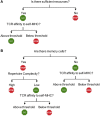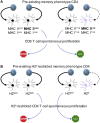Spontaneous T Cell Proliferation: A Physiologic Process to Create and Maintain Homeostatic Balance and Diversity of the Immune System
- PMID: 29616038
- PMCID: PMC5868360
- DOI: 10.3389/fimmu.2018.00547
Spontaneous T Cell Proliferation: A Physiologic Process to Create and Maintain Homeostatic Balance and Diversity of the Immune System
Abstract
Naive T lymphocytes undergo heterogeneous proliferative responses when introduced into lymphopenic hosts, referred to as "homeostatic proliferation" and "spontaneous proliferation." Spontaneous proliferation is a unique process through which the immune system generates memory phenotype cells with increasing T cell receptors repertoire complexity. Here, the mechanisms that initiate and control spontaneous proliferation are discussed.
Keywords: T cells; homeostasis; lymphocytes; lymphopenia; proliferation.
Figures



References
Publication types
MeSH terms
Substances
Grants and funding
LinkOut - more resources
Full Text Sources
Other Literature Sources
Medical

